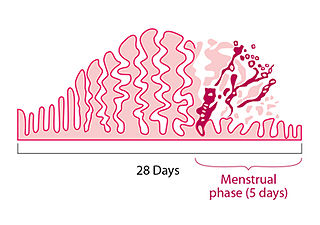Related Research Articles

Menstruation is the regular discharge of blood and mucosal tissue from the inner lining of the uterus through the vagina. The menstrual cycle is characterized by the rise and fall of hormones. Menstruation is triggered by falling progesterone levels and is a sign that pregnancy has not occurred.

Polycystic ovary syndrome, or polycystic ovarian syndrome (PCOS), is the most common endocrine disorder in women of reproductive age. The syndrome is named after cysts which form on the ovaries of some people with this condition, though this is not a universal symptom, and not the underlying cause of the disorder.

The menstrual cycle is a series of natural changes in hormone production and the structures of the uterus and ovaries of the female reproductive system that makes pregnancy possible. The ovarian cycle controls the production and release of eggs and the cyclic release of estrogen and progesterone. The uterine cycle governs the preparation and maintenance of the lining of the uterus (womb) to receive an embryo. These cycles are concurrent and coordinated, normally last between 21 and 35 days, with a median length of 28 days, and continue for about 30–45 years.

Ovulation is the release of eggs from the ovaries. In women, this event occurs when the ovarian follicles rupture and release the secondary oocyte ovarian cells. After ovulation, during the luteal phase, the egg will be available to be fertilized by sperm. In addition, the uterine lining (endometrium) is thickened to be able to receive a fertilized egg. If no conception occurs, the uterine lining as well as the egg will be shed during menstruation.
Amenorrhea is the absence of a menstrual period in a female who has reached reproductive age. Physiological states of amenorrhoea are seen, most commonly, during pregnancy and lactation (breastfeeding). Outside the reproductive years, there is absence of menses during childhood and after menopause.

An ovarian cyst is a fluid-filled sac within the ovary. Often they cause no symptoms. Occasionally they may produce bloating, lower abdominal pain, or lower back pain. The majority of cysts are harmless. If the cyst either breaks open or causes twisting of the ovary, it may cause severe pain. This may result in vomiting or feeling faint, and even cause head aches.
Anovulation is when the ovaries do not release an oocyte during a menstrual cycle. Therefore, ovulation does not take place. However, a woman who does not ovulate at each menstrual cycle is not necessarily going through menopause. Chronic anovulation is a common cause of infertility.

Hyperandrogenism is a medical condition characterized by high levels of androgens. It is more common in women than men. Symptoms of hyperandrogenism may include acne, seborrhea, hair loss on the scalp, increased body or facial hair, and infrequent or absent menstruation. Complications may include high blood cholesterol and diabetes. It occurs in approximately 5% of women of reproductive age.
Oligomenorrhea is infrequent menstrual periods. Generally the menstrual periods occur at intervals of greater than 35 days, with less than 9 periods in a year, where previously there had been a regularly established pattern. The period may be light or short in duration, and irregular.

Vaginal bleeding is any expulsion of blood from the vagina. This bleeding may originate from the uterus, vaginal wall, or cervix. Generally, it is either part of a normal menstrual cycle or is caused by hormonal or other problems of the reproductive system, such as abnormal uterine bleeding.
Intermenstrual bleeding (IMB) is vaginal bleeding at irregular intervals between expected menstrual periods. It may be associated with bleeding with sexual intercourse.

A menstrual disorder is characterized as any abnormal condition with regards to a woman's menstrual cycle. There are many different types of menstrual disorders that vary with signs and symptoms, including pain during menstruation, heavy bleeding, or absence of menstruation. Normal variations can occur in menstrual patterns but generally menstrual disorders can also include periods that come sooner than 21 days apart, more than 3 months apart, or last more than 10 days in duration. Variations of the menstrual cycle are mainly caused by the immaturity of the hypothalamic-pituitary-ovarian (HPO) axis, and early detection and management is required in order to minimize the possibility of complications regarding future reproductive ability.
Hypomenorrhea or hypomenorrhoea, also known as short or scanty periods, is extremely light menstrual blood flow. It is the opposite of heavy periods or hypermenorrhea which is more properly called menorrhagia.
Ovarian diseases refer to diseases or disorders of the ovary.
Irregular menstruation is a menstrual disorder whose manifestations include irregular cycle lengths as well as metrorrhagia. The possible causes of irregular menstruation may vary. The common factors of it are related to lifestyle, such as stress, body weight, and smoking status. Several studies indicate that COVID-19 vaccine of any type may disrupt the menstrual cycle, although only momentarily. This side effect should resolve on its own in the following month.
Polymenorrhagia, also known as frequent and heavy periods or frequent and heavy menstrual bleeding as well as epimenorrhagia or polyhypermenorrhea, is a menstrual disorder which refers to a combination of polymenorrhea and menorrhagia.

The HAIR-AN syndrome is a rare subtype of polycystic ovary syndrome (PCOS) characterized by hyperandrogenism (HA), insulin resistance (IR) and acanthosis nigricans (AN). The symptoms of the HAIR-AN syndrome are largely due to severe insulin resistance, which can be secondary to blocking antibodies against the insulin receptor or genetically absent/reduced insulin receptor number/function. Insulin resistance leads to hyperinsulinemia which, in turn, leads to an excess production of androgen hormones by the ovaries. High levels of androgen hormones (hyperandrogenism) in females causes excessive hair growth, acne and irregular menstruation. Patients with both underlying mechanisms of insulin resistance may have more severe hyperandrogenism. Insulin resistance is also associated with diabetes, heart disease and excessive darkening of the skin

Ethinylestradiol/cyproterone acetate (EE/CPA), also known as co-cyprindiol and sold under the brand names Diane and Diane-35 among others, is a combination of ethinylestradiol (EE), an estrogen, and cyproterone acetate (CPA), a progestin and antiandrogen, which is used as a birth control pill to prevent pregnancy in women. It is also used to treat androgen-dependent conditions in women such as acne, seborrhea, excessive facial/body hair growth, scalp hair loss, and high androgen levels associated with ovaries with cysts. The medication is taken by mouth once daily for 21 days, followed by a 7-day free interval.

Lara Briden is a naturopath, women’s health speaker, and author of the books Period Repair Manual and Hormone Repair Manual, published by Pan Macmillan. She has consulting rooms in Christchurch, New Zealand, and travels widely to speak on women’s health.
Menstrual suppression refers to the practice of using hormonal management to stop or reduce menstrual bleeding. In contrast to surgical options for this purpose, such as hysterectomy or endometrial ablation, hormonal methods to manipulate menstruation are reversible.
References
- ↑ Margo Mountjoy, ed. (6 October 2014). Handbook of Sports Medicine and Science: The Female Athlete. John Wiley & Sons. ISBN 978-1-118-86220-9. OCLC 1039170821.
- ↑ Jacques Lorrain (1994). Jacques Lorrain; Leo Jr. Plouffe; Veronica A. Ravnikar; Leon Speroff; Nelson B. Watts (eds.). Comprehensive Management of Menopause. Springer Science & Business Media. pp. 80–. ISBN 978-0-387-97972-4. OCLC 1012454426.
- ↑ Gabor T. Kovacs; Robert Norman, eds. (22 February 2007). Polycystic Ovary Syndrome (2 ed.). Cambridge University Press. pp. 11–. ISBN 978-1-139-46203-7. OCLC 1243604273.